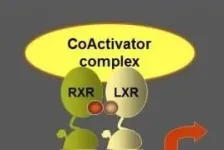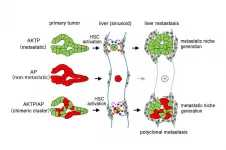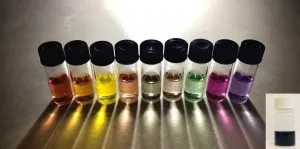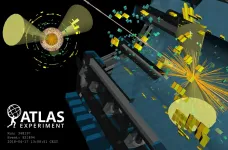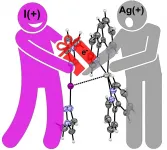(Press-News.org) Tumor cells are able to avoid the attack of the immune system through several mechanisms. For instance, these can secrete factors that turn macrophages -cells in the immune system- into dual action agents that contribute to the tumor progress and will protect it from immune body defences: these become, thus, the tumor-associated macrophages (TAMs).
An article published in the journal Cancer Research describes a new molecular mechanism that counteracts the immunosupressive action of these macrophaes to boost tumor growth, and brings knowledge of potential interest for the design of future therapeutical options against cancer. The preclinical study is led by the tenure-track 2 lecturer Annabel Valledor, from the Faculty of Biology and the Institute of Biomedicine of the University of Barcelona (IBUB).
Among the participants are also the researchers of the Faculty of Pharmacy and Food Sciences of the UB, the Josep Carreras Leukaemia Research Institute, the Sant Pau Institute of Biomedical Research, the University of Las Palmas de Gran Canaria, University College London, and the Free University of Brussels, among others.
Macrophages that boost tumor growth
Macrophages are cells in the immune system that unfold several functions (they kill invasive pathogens, remove cells or damaged tissue, etc.). However, in the tumoral microenvironment, tumor-associated macrophages can become an enemy to patients with cancer. Therefore, a field of study of great outreach in biomedicine is the one finding strategies to activate TAMs and help the immune system fight tumors, as well as improve the effects of anticancer therapies.
The article published in Cancer Research describes how the action of a compound known as TO901317 limits the ability of TAMs to protect the tumor in laboratory animals. According to the results, the TO901317 compound can inhibit the synthesis of molecules that serve to attract regulatory T lymphocytes (Treg) to the tumor.
"In a healthy person, the most important function of Treg is to maintain the balance of the immune system and avoid unwanted responses towards the own body. However, in a tumor, Treg stop the antitumoral activity of other types of lymphocytes. Actually, several studies show that a high number of Treg in the tumoral microenvironment suggests a worse prognosis", notes lecturer Annabel Valledor, from the Department of Cell Biology, Physiology and Immunology and IBUB.
Antitumoral effects of LXR activation
In particular, the TO901317 compound acts on the liver X receptor (LXR), a transcription factor of the family of nuclear receptors that regulates the gene expression with a key role in the activity of macrophages and the metabolism.
As stated in the article, the activation of LXR by the antagonist TO901317 inhibits the expression of the transcription factor IRF4 in macrophages. Specifically, the IRF4 factor is necessary so that chemokines Ccl17 and Ccl22 are expressed as a response to signals such as interleukin IL-4 or the GM-CSF factor. As a result, the action of the TO901317 compound inhibits the production of chemokines Ccl17 and Ccl22, which are important for the recruitment of regulatory T lymphocytes to the tumoral microenvironment.
"Once the LXR is activated, tumor-associated macrophages undergo important changes in their gene expression profile, and as a result, their ability to produce molecules with an immunopressive function in the tumoral microenvironment decreases", notes researcher Joan Font Díaz, from the Faculty of Biology and IBUB.
This action is correlated to a decrease in the number of Treg in the tumor and a slower tumor growth, as stated by the authors of the study.
INFORMATION:
Most tumors consist of a heterogenous mix of cells. Genetic mutations found only in some of these cells are known to aid with the spread and progression of cancer. However, oncologists often find that when tumors metastasize to distant organs, they retain this heterogenous nature--a phenomenon termed "polyclonal metastasis". The mechanism by which non-metastatic cells accompany the metastatic cells is ambiguous. Now, Masanobu Oshima and his research team have used mouse models to explain how non-metastatic cells begin their long commute.
The team has previously developed various cancerous mutants of mice and analyzed ...
New research shows that hurricane maximum wind speeds in the subtropical Atlantic around Bermuda have more than doubled on average over the last 60 years due to rising ocean temperatures in the region.
Hurricanes intensify by extracting energy from the warm ocean surface via air-sea heat fluxes, so a warmer ocean can lead to more intense hurricanes.
Improving predictions of wind speeds from hurricanes will help determine the right level of response in advance of the storm and potentially limit the resulting damage in Bermuda.
Between 1955 and ...
Hydrogen for energy use can be extracted in an environmentally friendly way from water and sunlight, using photocatalytic composite polymer nanoparticles developed by researchers at Uppsala University. In laboratory tests, these "polymer dots" showed promising performance and stability alike. The study has been published in the Journal of the American Chemical Society.
How we are to meet future demand for sustainable energy is a much-debated question. One feasible way to go is hydrogen, which can be produced from renewable resources: water and solar energy. But the process ...
Cisplatin is one of the most effective chemotherapy agents, used in just under half of pediatric cancer cases. Permanent hearing loss is a common side effect of this medication, but until now, studies have been too small and too varied to accurately characterize this risk. Today in The Lancet Child & Adolescent Health, investigators at Children's Hospital Los Angeles published results of the largest study of cisplatin-induced hearing loss to date. The study establishes the first benchmarks for the prevalence of hearing loss, and reveals that the risk of hearing loss is affected not only by how much drug is given, but by how that drug is delivered--dosing schedules, complementary treatments, and more. These findings will allow oncologists to deliver more information ...
If you're poor and terminally ill in southern Mexico, there's far less chance you'll get the painkillers you need for palliative care than your cousins in more prosperous regions, particularly those pharmacy-rich areas along Mexico-U.S. border, say UCLA researchers and colleagues who studied opioid dispensing levels across the country.
What's more, the researchers' paper in the journal The Lancet Public Health suggests it's likely that some of the opioids intended for Mexican citizens are ending up in American pockets.
Despite a Mexican government initiative launched in 2015 to improve access to prescription opioids among palliative care patients, the country has seen only a marginal increase in dispensing levels, and inequities in dispensing ...
A novel computer algorithm, or set of rules, that accurately predicts the orbits of planets in the solar system could be adapted to better predict and control the behavior of the plasma that fuels fusion facilities designed to harvest on Earth the fusion energy that powers the sun and stars.
The algorithm, devised by a scientist at the U.S. Department of Energy's (DOE) Princeton Plasma Physics Laboratory (PPPL), applies machine learning, the form of artificial intelligence (AI) that learns from experience, to develop the predictions. "Usually in physics, you make observations, create a theory based on those observations, and then use that theory to predict new observations," said PPPL physicist Hong Qin, author of a paper detailing ...
Monash University researchers have uncovered the barrier to β-cell (beta cell) regeneration that could pave the way for improved treatments for diabetes and diseases that involve organ and tissue damage.
The human body doesn't repair itself very well, with our liver the only organ that can regenerate efficiently. We have limited capacity to regenerate new cells or tissue after birth as the genes involved in development are switched off.
This process happens through DNA methylation, a biological process where chemicals (methyl groups) are written on DNA and modify the way the gene functions. ...
A team of researchers at Lawrence Berkeley National Laboratory (Berkeley Lab) used a quantum computer to successfully simulate an aspect of particle collisions that is typically neglected in high-energy physics experiments, such as those that occur at CERN's Large Hadron Collider.
The quantum algorithm they developed accounts for the complexity of parton showers, which are complicated bursts of particles produced in the collisions that involve particle production and decay processes.
Classical algorithms typically used to model parton showers, such ...
An international research team led by Professor Kari Rissanen of the University of Jyvaskyla (Finland) and Professor Antonio Frontera of the University of Balearic Islands (Spain) has demonstrated that positively charged iodine (termed iodonium) is able to favorably interact with a silver cation (Ag+), overcoming the strong electrostatic repulsion. The research was published online in Chem -journal 8th of February 2021.
It is well known and intuitive that iodide (I-) has a strong affinity for Ag+. For instance, AgI is one of the most insoluble inorganic salts ...
When we listen to speech sounds, the information that enters our left and right ear is not exactly the same. This may be because acoustic information reaches one ear before the other, or because the sound is perceived as louder by one of the ears. Information about speech sounds also reaches different parts of our brain, and the two hemispheres are specialised in processing different types of acoustic information. But how does the brain integrate auditory information from different areas?
To investigate this question, lead researcher Basil Preisig from the University of Zurich collaborated with an international team of scientists. In an earlier study, the team discovered that the brain integrates information about speech sounds by 'balancing' the rhythm of gamma waves across ...
